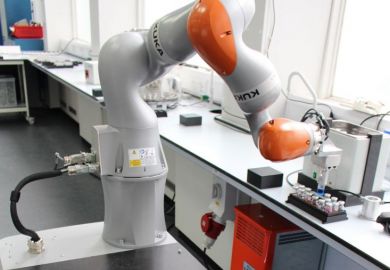Between one and three million people, many of them children, are poisoned by pesticides in the world each year I". "One recent study suggests that this (a pesticide against head lice) use may increase the risk of brain cancer in children."
These are just two of the alarming statements to be found in John Wargo's Our Children's Toxic Legacy, in the chapter "Susceptibility of children". What they mean depends on the way we understand the word "poisoned" in the first quote, and "suggests" in the second. It could be there is nothing to worry about at all.
This is a deeply disturbing book - in many ways. It is written by a man committed to the idea that minute traces of manmade pesticides are a terrible threat to mankind (or at least to American children) and that the United States law-makers and government agencies are failing to deal with the problem properly. Wargo acknowledges that pesticides have probably done some good, for example by greatly increasing food production, or by clearing a country of malarial mosquitoes, but he does not dwell on these aspects. Instead he agonises about what pesticide residues might be doing to harm us, drawing upon research findings that are mainly inconclusive or that provide only tentative evidence. But like so many committed environmentalists, Waldo sees the mists of scientific uncertainty as evidence that there really is a pit of doom ahead.
Our Children's Toxic Legacy sounds like a typical alarmist tract, but it is in fact an academic work. Wargo's book is a scholarly study of the US laws enacted to protect citizens and the nation's food and water supplies, and how these have failed to prevent exposure to traces of commercial pesticides. Some sections of the book are superb, such as the chapter that recounts the fight against malaria in the early part of this century using the primitive methods then available. The book also contains a great deal of useful data on US environmental law and how this has evolved in a rather haphazard way. The chapter on the diet of children is also soundly written.
Wargo's speciality is public policy and legislation and, when he deals with these, his authority is reassuring. He traces the slow progress that has been made in environmental law-making from the 1940s to the present day. Early regulations were rather weak and regulators were lax and unduly influenced by the manufacturers of pesticides, which encouraged the abuses that led to environmental damage. The first checks to their excesses began in the late 1950s, and happily there are now much tighter regulations, with some once-used chemicals banned. Waldo points out the irony that US companies are still allowed to manufacture and export such insecticides, only to have them return as residues on the growing volume of imported food.
The most famous limitation on the use of chemicals came with the Delaney clause to the Food and Drug Administration Act of 1958 that stated: "The secretary shall not approve for use in food any chemical additive found to induce cancer in man, or, after tests, found to induce cancer in animals." It could not be foreseen that mice would be bred that are so sensitive that almost any unusual chemical will cause them to get cancer. For 20 years these sad little creatures have underpinned alarms and scares about chemicals in agriculture and food, most of which we now know pose no threat to humans.
Perhaps it is unfair to seek objectivity in a book like this, but it would have been welcome. The emphasis on children seems somewhat misplaced. The justification appears to be that the young are most at risk from cancer, because they are growing rapidly and because dividing cells are especially vulnerable to carcinogens, such as environmental ones. Proof, in the form of medical evidence, is not forthcoming to support this conjecture. And, if it is true, why is Wargo reluctant to apply to natural pesticides the same criteria he uses to judge manmade pesticides? Natural pesticides, produced by plants to protect themselves against attacks by insects, can be proved to be carcinogenic, and yet we eat them regularly and in vastly greater quantities than manmade pesticide residues.
The distinguished scientists Bruce Ames and Lois Gold have put the threats from natural and manmade pesticides into proper perspective, but Wargo dismisses their views, claiming their findings relate to atypical diets or do not apply to children. The result is that Ames and Gold's seminal work merits only brief coverage, yet Wargo devotes a whole chapter, "The complex mixture problem", to the unproven idea that manmade pesticides might somehow enhance the toxicity of one another, thereby making them especially dangerous.
At the end of the book Wargo sets out a series of carefully argued reforms, some of which merit careful consideration, such as the suggestion to scrap the Delaney clause because it leads to absurdities when stringently applied, denying Americans the use of benign chemicals while permitting more dangerous ones to be used because they pass the cancer test. Finally, in an epilogue, he concludes that future generations will judge our attempts to carry out better chemical analyses of environmental components as a mere distraction, and that we should have given priority to moral issues when we make our decisions. If so then I fear the New Dark Age really is dawning.
Meanwhile I will continue to support the efforts of chemists to develop the teaching of toxicology, and this will need the support of textbooks such as Fundamental Toxicology for Chemists. It begins with an excellent overview chapter by one of its editing authors, John Duffus of Heriot-Watt University. Then follow 20 other chapters by contributors, mainly from the UK, but also from Germany, France and Canada. The early ones concentrate on general themes such as data interpretation, risk assessment and management, exposure and monitoring, carcinogenicity and reproductive toxicity. The middle part of the book focuses on the parts of the body affected by toxins: the immune system, skin, lungs, liver, kidney and nervous system. The final chapters cover a variety of topics such as behavioural toxicity, biocides and pesticides, radionuclides, the safe handling of chemical and ecotoxicity.
I was disappointed that the chapter on pesticides, by Birger Heinzow, was only eight pages long, but nevertheless it is an excellent primer for anyone new to the subject of chemical pesticides. One of the more thought-provoking chapters was that on behavioural toxicity, which appears to be evolving from both psychology and neurotoxicity and deals with the way toxins affect the brains of mammals. Its author, Gerhard Winneke, of Heinrich-Heine University, Dusseldorf, argues convincingly for this branch of toxicology to be accepted, and for it to embrace not only animal behaviour but human behaviour as well. Two toxins are given special coverage in the chapter, lead and PCB. Animal experiments can prove the effects of these on the learning processes, but Winneke points out that it is still hard to convince regulatory bodies, and even fellow scientists, that children are similarly at risk.
The chapter on data interpretation, by John Fowler, neatly encapsulates the errors and faults many activists make in their rush to condemn the dangers of chemicals. Indeed the summary of questions Fowler says should be answered before any action is taken ought to be science's first line of defence against the alarms of environmentalist mischief makers.
At the end is an appendix outlining a curriculum for teaching a university course on toxicology, followed by an excellent 75-page glossary of toxicological terms. I suspect these are there to please the International Union of Pure and Applied Chemistry, whose committees on toxicology and the teaching of chemistry have approved the book. I even thought I could detect the dead hand of committee bureaucrats resting on some of the chapters.
In the West we can afford to worry about long-term environmental issues. In less developed countries these have to take second place to slightly more urgent ones that affect children: poverty, malnutrition, starvation and their attendant diseases. The Environment for Children concentrates on these rather than on pesticide residues and global warming, although these western obsessions get a mandatory mention. The lead author is David Satterthwaite, director of the human settlements programme at the International Institute for Environment and Development.
This multidisciplinary work deserves a wide audience. Academic researchers might be disappointed because it contains little in the way of hard fact but general readers will find much of the detail fascinating. Some of the most moving parts are the human interest stories in boxes dotted throughout the text graphically to illustrate points being made - tales of villagers uniting to install drains and fresh water or fighting off those who come to fell their trees.
The first part deals well with the main theme, of the links between the environment and child health. The book then turns to renewable resources and sustainable development, but the chapter that interested me most was one that I suspect was written by one of contributing authors, Jac Smit, of the curiously named Urban Agriculture Network. In this chapter we have a wonderful example of what backyard food production really can achieve, and this is to be found in Yang Puzhong on the outskirts of Bozhou, China. Here there is a chicken house with 20 hens, whose droppings fall as manna into a pigsty where they are consumed by eight pigs, whose excreta, along with that from humans, supply a methane generator, the waste liquid from which runs into a fish pool rearing several varieties of carp and turtles, and around whose perimeter grows a vine that produces a ton of grapes a year.
Such delightful stories of self-help and selfsufficiency may offer hope to some of the world's poor, of whom there are 940 million living in rural poverty and 1.6 billion in cities. The long chapter six, entitled "Primary environmental case", is a down-to-earth analysis of how these people really can be helped to a better life through better sanitation and land reclamation. A reader gains some idea of the discomfiture the affluent Victorians must have felt when their attention was drawn to the victims of 19th-century industrialisation.
Like them I wonder and worry - but take no action. However, unlike most of them I cannot blame the shiftless and thriftless poor for their own plight, or tut-tut at their lack of birth control, or philosophise that it is all part of a natural equilibrium that we may shift temporarily, but will in the end reimpose itself. Such views were wrong then and are wrong now. This book shows how much can be changed simply through cleaner drinking water, better sanitation and better housing. In Victorian times men had to be motivated to bring about the changes in living conditions. Today the answer lies in educating and empowering women, and with the help of organisations such as Unesco and Oxfam remarkable benefits can be achieved. It is poor women who will unlock the door to a better future for their children and ultimately move their societies on to a quality of life where pesticide residues can appear to be a serious threat.
John Emsley is science writer in residence, Imperial College, London.
Fundamental Toxicology for Chemists
Editor - John H. Duffus and Howard G. J. Worth
ISBN - 0 85404 529 5
Publisher - Royal Society of Chemistry
Price - £29.50
Pages - 3


